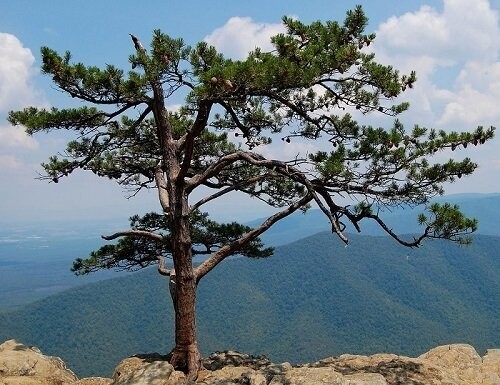Pinus pungens, Table mountain pine 7.5L 80-90cm
Pinus Pungens, Table Mountain Pine, USDA H5-hardy, very rare in cultivation
| Scientific name: Pinus pungens A.Lambert 1806 Common names: Hickory pine, Prickly pine, Table Mountain pine Description Tree to 20(-30) m tall, with trunk to 0.4(-0.8) m in diameter, often crooked and irregular in cross section. Bark thin, reddish brown to dark gray, breaking up into flaky, elongate plates between shallow, dark furrows. Crown flat-topped, irregular, and open, with a few, thick, upwardly angled branches sparsely clothed with foliage. Twigs orange-brown, tough but snapping at their breaking point, rough with the bases of scale leaves, hairless. Buds 6-9 mm long, resinous. Needles in bundles of two (or three), each needle (3-)4-9(-10) cm long, twisted, stiff, and prickly (hence the scientific name, Latin for “piercing”), lasting (2-)3 years, dark green. Individual needles with conspicuous, narrow lines of stomates on both the inner and outer faces, and (0-)2-7(-11) resin canals at the corners, and in between, midway between the needle surface and the two-stranded midvein. Sheath 5-10 mm long, weathering to 4-6 mm and persisting and falling with the bundle. Pollen cones 12-18 mm long, reddish purple. Seed cones (4-)6-8(-10) cm long, plumply egg-shaped, asymmetrical, with 90-140 seed scales, green before maturity, ripening shiny light yellowish brown, opening gradually from the middle over the course of 2-3(-5) years and then persisting another several years (up to about 30!) before falling with the very short stalks (to 1 cm long). Seed scales wedge-shaped, the exposed face horizontally diamond-shaped, protruding as a low pyramid crossed by a sharp ridge topped by a prominent umbo bearing a strong, sharp, upcurved spine (another justification for the scientific name). Seed body 4-6(-7) mm long, the firmly attached wing another (10-)15-22(-30) mm longer. Appalachian Mountains and adjoining Piedmont of the eastern United States, from central Pennsylvania to northeastern Georgia. As scattered small groves or single trees among oaks and other fire-tolerant hardwoods; (100-)350-1,100(-1,400) m. Conservation Status Red List Category & Criteria: Least Concern |


